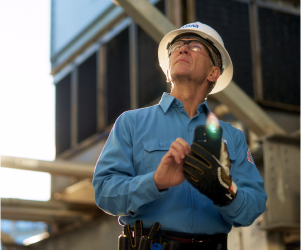Every Wednesday night, I’m supposed to go around the house, collect the trash, and take it out to the curb. Sometimes I ‘forget’ (read: I don’t feel like it), but other than my wife getting upset with me, it’s really not a big deal. In your facility, however, waste management is much more serious. You’ve got important issues to consider and plan for, such as:
- methods of storing waste on-site
- container space required
- container and compactor safety standards
- procedures for gathering and depositing waste
Methods of Storing Wastes On-Site
Wastes are normally stored on the property in one or more containers designed to meet transportation requirements. These include the following:
- front-load containers
- rear-load containers
- roll-off containers
- stationary compactors
Each container has advantages and disadvantages based on the types and quantities of wastes generated and the amount of storage space available. Container sizes are normally given in cubic feet or cubic yards. The following table provides the volume for some of the more typical waste container sizes:
|
Container Size |
Waste Volume |
|
1 yd |
27.0 cubic feet |
|
Garbage can: 18– |
3.6 cubic feet |
|
Garbage can: 16– |
2.0 cubic feet |
|
Bushel basket (standard) |
1.24 cubic feet |
|
Barrel (U.S. standard) |
4.08 cubic feet |
|
7.5 gallon (U.S.) |
1 cubic foot |
|
1 gallon (U.S.) |
0.134 cubic feet |
|
55– |
7.0 cubic feet |
Front-Load Containers
Front-load containers are appropriate for low-density wastes such as food and general garbage. Vehicles that empty them are equipped with hydraulic arms at the front of the truck body that allow the vehicle to hook into the sides of the container and unload the waste into a compartment located on top of the truck behind the cab. Standard containers are 72 inches long, 36 to 66 inches wide, and hold from 2 to 12 cubic yards of waste, depending on the size. In a front-load container, all waste is stored in a single, closed container to discourage insects, rodents, and other pests. Unauthorized use of front-load containers is not easily controlled, however, and ample overhead space and truck-turning area are required to accommodate the trucks that make pickups. Standard front-load container dimensions and volumes are shown below.

Rear-Load Containers
Urban properties with a limited amount of space frequently require rear-load containers to collect their wastes. Rear-load containers are designed for use with vehicles that must back up to the container to load it. Rear-load containers are smaller than front-load containers and range in volume from 0.5 to 10 cubic yards. The bins are trapezoidal and are often mounted on casters, which enables them to be moved to accessible areas for pickup. Like front-load containers, rear-load containers are equipped with hinged lids to discourage rodents and other pests.
Roll-Off Containers
Businesses and institutions with bulky, non-compactable wastes such as wooden pallets, sawdust, paper, and other materials are best served by roll-off containers. These large boxes are transported on trucks equipped with hydraulic cable systems that enable the containers to be rolled off the trucks at the customer’s location. Roll-off containers range in volume from 20 to 40 cubic yards; their dimensions vary only in height, with length and width standardized at 8 by 22 feet. Standard volumes and dimensions for roll-off containers are shown below.
Because roll-off containers are capable of holding a larger volume of waste than front-load or rear-load containers, fewer total storage receptacles are needed overall. They are available as open-top boxes or closed compaction units and can be hand-fed, chute-fed, or hopper-fed. In fact, their 7- to 8-foot-long rear doors accommodate bulky or heavy materials that must be deposited by forklift. As open-top boxes, roll-off containers are far less efficient at controlling pests than front-load containers or closed compactors. Like front-load containers, roll-off boxes require ample space for pickups and are difficult to monitor for unauthorized use.
Stationary Compactors
High-volume, low-density wastes, such as cardboard and large volumes of food wastes, are managed most effectively with a stationary compactor or baler. Stationary compactors are, well, stationary; they are not removed from their location while being unloaded. Compactors are well suited for cafeteria service areas or kitchens, where food is prepared and wet garbage is produced. Ranging in length from 22 to 26 feet, compactors can be located outdoors in tandem with roll-off containers, or can be built into the building structure. Depending on the waste materials, four to five times more waste can be handled by a roll-off container if it is attached to a compactor system. Therefore, the total frequency of collections is reduced. Built-in compactors save floor space by allowing wastes to be deposited in an indoor hopper, where they are compressed and funneled to the main storage container outside the building. Because they are fully enclosed, stationary compactors prevent wastes from harboring rodents or pests.

Container Space Required
A waste storage area to accommodate containers and collection vehicles should be incorporated into new building design and construction. The surface of the waste storage area should be constructed of concrete, not blacktop material, because blacktop surfaces are easily destroyed by truck traffic and container movement. Ample service space must be allowed in or near the parking area for storing wastes in any of the container types mentioned above. The containers should never be positioned underground, and they must be surrounded by enough unoccupied area to give collection vehicles a sufficient turning radius.
Front-load trucks must have enough space to drive onto the property, lift and empty the container with forward hydraulic arms, turn around, and exit the property. If the front-load container is surrounded by a fence or other enclosure, the gate on the enclosure should be at least 10 feet wide to allow the vehicle to reach the container without damaging the fence. Because rear-load containers are normally used on properties with limited space, rear-load vehicles need sufficient room to back up to the container, lift and empty it, and exit the property. If the rear-load truck is unable to reach the container, the rear-load box must be rolled to an accessible area for each pickup. The turning areas required for front-load, rear-load, and roll-off vehicles are illustrated below.

Roll-off vehicles that service open-top roll-off boxes and compactors need enough space to switch an empty container for a full one. The vehicle normally deposits the new container next to the existing box, so room should be reserved for both containers. Because stationary compactor systems are often located on or near loading dock areas, replacement compactor containers must be repositioned in their designated spots. Roll-off vehicles should unload an empty container, remove the full unit, and maneuver the replacement container into its proper position.
If an adequate container storage area cannot be developed during building construction or remodeled later, the risk of damage to the building, landscaping, or parked vehicles increases. In those cases, the property owner or manager may choose to have a cleaning company perform nightly pickups and dispose of the waste off-site.
Container and Compactor Safety Standards
The American National Safety Institute (ANSI) provides several standards on compactors and containers and the safety requirements associated with this equipment. These standards affect the design, manufacture, installation, modification, operation, and maintenance of equipment used in waste management. It also addresses facilities and activities in which this equipment is used.
These standards include:
- ANSI/Z245.1-1999, Mobile Wastes and Recyclable Materials Collection, Transportation, and Compaction Equipment Safety Requirements
- ANSI/Z245.2-2004, Stationary Compactors—Safety Requirements for Installation, Maintenance, and Operation
- ANSI/Z245.21-2004, Stationary Compactors—Safety Requirements
- ANSI/Z245.30-1999, Waste Containers—Safety Requirements
- ANSI/Z245.41-2004, Facilities for the Processing of Commingled Recyclable Materials—Safety Requirements
- ANSI/Z245.5-1997, Baling Equipment—Safety Requirements
- ANSI/Z245.60-1999, Waste Containers—Compatibility Dimensions
Procedures for Gathering and Depositing Wastes
An on-site maintenance staff that provides routine cleaning services also frequently empties desk-side or centrally located receptacles and transports the wastes to outside containers. If occupants are directly responsible for supplying their own waste disposal services under the terms of their leases, they are usually required to gather and deposit their own wastes in outside containers. Again, this arrangement is found more frequently in strip-center properties than in single-tenant or multiple-tenant office buildings.
Recycling
All this talk about trash, and no mention of recycling? The fact is that even if you are not, yourself, an “eco-warrior,” you need a recycling program for several reasons. How to establish and/or improve upon such a program will be the topic for a future How To article from BOMI International.
This article is adapted from BOMI International’s The Design, Operation, and Maintenance of Building Systems, Part II. More information regarding this is available by calling 1-800-235-2664, or by visiting www.bomi.org.




